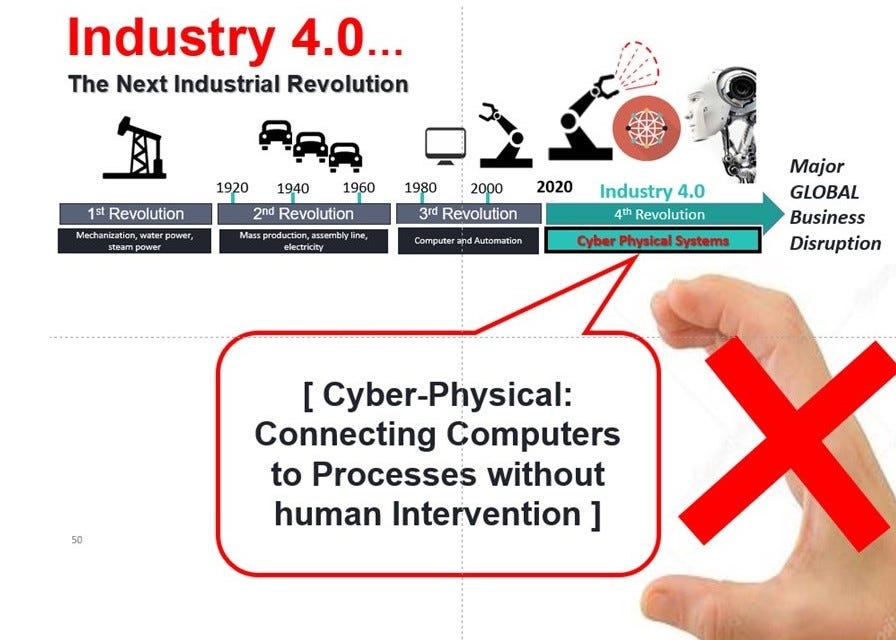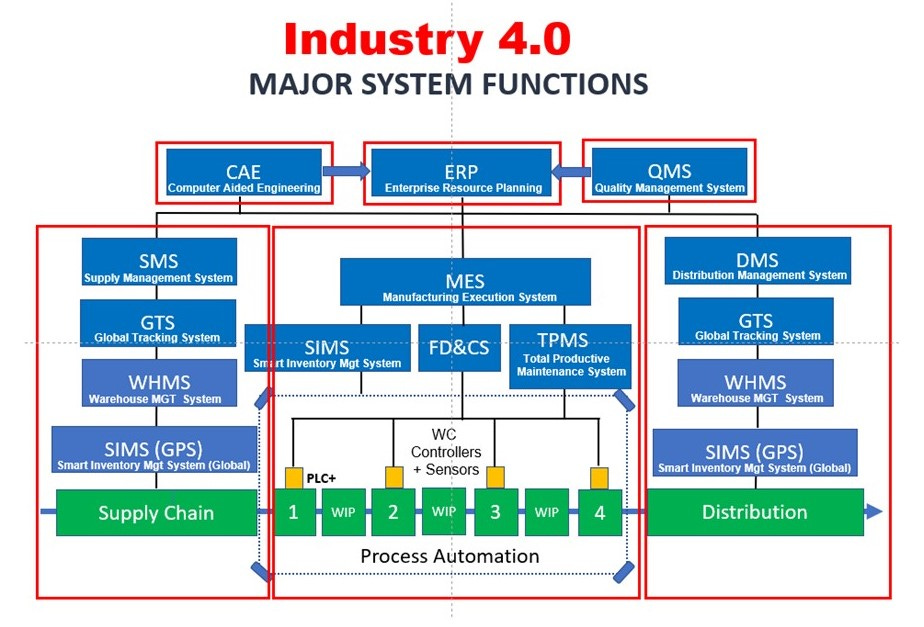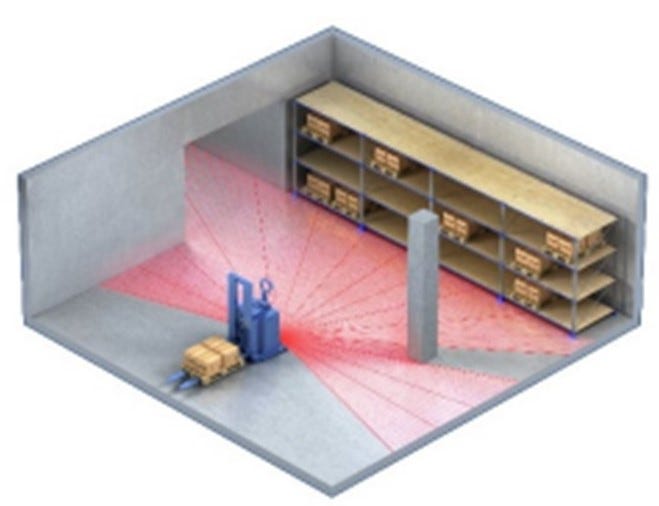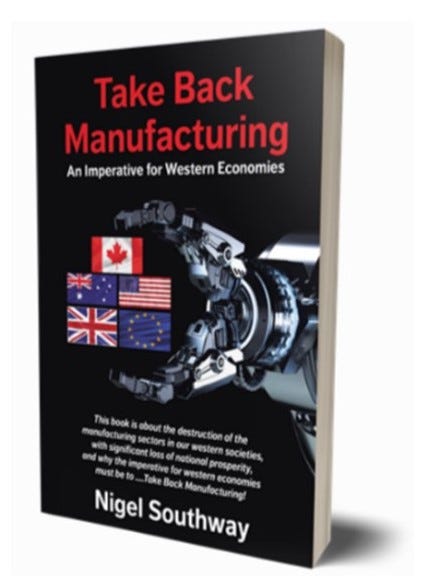The Promise of Industry 4.0
To stay competitive, many industries are starting to embrace Industry 4.0 which is now deemed to be the next Industrial revolution.
Almost every industrial sector is under pressure from consumers and national governments to reduce costs while localizing supply chains to better support affordability and recover national prosperity.
The industries are also facing increasing legislation on the control of products for reasons ranging from consumer health to national security, significant product and process certification, traceability, proof-of-origin, and preferred localized supply.
Due to this, and to stay competitive, many industries are starting to embrace Industry 4.0 which is now deemed to be the next Industrial revolution.
This is being driven by the emergence of new advanced technologies generating new forms of innovation some are calling the Age of Technological Disruption.
Industry 4.0 …. Productivity to the next level
Sometimes this Industry 4.0 initiative is called “Digital Transformation” but whatever the handle used, its about improving productivity and getting rid of the waste in the whole business process using new disruptive digital technologies.
Industry 4.0 working in concert with LEAN practices can optimise the value stream in the manufacturing process, and better manage the control of materials and resources. It can support the planning of manufacturing as well as improve information, decisions, and actions in real time at the point of use. It will assist in reducing direct labor and the supporting workforce, and will improve operational flexibility, reliability and capability across the whole supply chain of a business.
The future challenge of every industry must be to learn how to access and innovate the application of these disruptive digital technologies and plan how to introduce them into the future business.
What is INDUSTRY 4.0
The first industrial revolution (INDUSTRY 1.0) was powered by water and steam to mechanize production.
The second industrial revolution (INDUSTRY 2.0) used electrical power and introduced mass production.
The third industrial revolution (INDUSTRY 3.0) added electronics, computers and information technologies to automate the production process.
The fourth industrial revolution (INDUSTRY 4.0) began with the digital age in the last decade and is characterized by a fusion of technologies such as artificial intelligence, sensors, robotics, the Internet of things that can generate what is being called cyber physical systems that are generating new forms of innovation in the products the manufacturing process and the total supply chain.
This may demand new facilities, capital, knowledge, skills, and systems, and must be fully integrated with LEAN thinking to ensure solutions are implemented without automating waste.
Correctly adopting such an imperative will provide an opportunity to change the competitive game, but much more needs to be done to assist the industries learn how these new technologies will be implemented.
In INDUSTRY 3.0 we added significant computerization to our manufacturing and business processes, but it created many environments in industry where we as humans got trapped in the process and ended up working for the computer, not the computers working for the process and benefiting us.
This has, in many cases, made us slaves to the computer. An example is how Enterprise Resource Planning systems still struggle with multiple transactions, some of them semi-manual or manual, to keep a firm real-time grip on a dynamic business process.
But INDUSTRY 4.0 will employ cyber-physical systems that will eliminate the human interface with sensors and smarter systems, so we will have computers working for us, not us working for the computers and eliminate the burden of managing computers by humans and allow direct linkage between the computers and the process.
The Key Disruptive Technologies
Here are the key disruptive technologies and how they will impact the future.
Networks / The industrial Internet of Things (IIOT).
Although the technical term is “connectivity,” the public is embracing the Internet of Things and its industrial version, the Industrial Internet of Things (IIoT).
This is suggesting that devices and therefore the knowledge they carry will be connected more than ever before. Again, it is about information and knowledge at the point of use in real time.
Advanced Robotics
Advanced Robotics means linking traditional computerized machine and automation technology with smart sensor systems and we are witnessing this technology growth as defined by the upturn in the shipments of industrial robots and automation systems of all types.
These automation systems using smart-sensor solutions are being described as “cyber physical systems” because they place the computer power even more in control of the process without human intervention, which solves most of the major interface issues between robots, computers and process management.
Artificial Intelligence (AI) and Big Data
In the last few years, computer technology has taken a huge leap forward in terms of computing power measured in operations per second. They can operate upon massive and multiple algorithms much faster than human thought, with almost the same level of complex logic and decision capability. This will generate enough information density and complex algorithm management to become a form of artificial intelligence. This improved computing power will enable computing systems to handle what the computer industry calls “Big Data,” so that everything we want to know about a subject or event can be stored as a complete body of knowledge at the point of use and used at will in real time.
Collaborative Connected Platforms
The other disruptor is collaborative and connected platforms that allow integration of both the physical and information, so that major system functions in a business become fully integrated across a whole supply chain. It can link the supply management and the execution systems and the distribution systems seamlessly together so that the major product development and planning tools such as Computer Aided Engineering and Enterprise Resource Planning can collaborate seamlessly to manage a total business.
This capability is breeding a “globalization of ideas” mentality using a cloud-based capability, and can enable constructive crowd sharing of resources, skills, knowledge, and funds in an interactive manner. The control of IP may become an issue, but in principle the globalization of ideas is far more sustainable than the globalization of manufacturing and materials.
Advanced Manufacturing
Advanced Manufacturing has been a continuum, but computerization and automation have made many advances into manufacturing techniques in recent years, and it has also changed the way information is planned and transferred such as CAD/CAM and the computer simulation of processes.
Perhaps the most recent addition to the manufacturing process toolkit has been 3D printers. This “additive technology” is now becoming highly capable in both plastic and metal and driving change in how and where traditional component manufacturing will be undertaken. It is already changing the game for both Rapid prototyping and hi performance tooling strategies to re-life traditional industries and breed new industries.
This technology is also being successively incorporated into medical and custom products to provide real time and close-to-customer solutions.
New printable building materials and composites is changing building fabrication, and its clear that the future marriage of this technology and new materials will take this technology into many sectors that will touch the population far more directly at the point of use much more than traditional manufacturing.
The next Industrial Revolution is on the way.
So, Industry 4.0 will enable the “smart-factory” concept and start us on a journey toward a new “business of the future” that will embrace all functions in a business, and provide an integrated and computerized business, and will control the whole supply chain. It will manage the core conversion processes from raw materials to finished products including the management of all the manufacturing automation processes and integrate them with the customer demand and fulfillment process.
These cyber-physical systems will work in partnership with LEAN thinking to eliminate transactional waste and solve some of the major interface issues between computers and process management.
These systems will use “SMART” Connectivity using sensor technology, IIOT networking technologies, and advanced wireless position and transaction-system technology.
These smart sensor systems are being described as “Cyber Physical Systems” because they place the computer power even more in control of the process without human intervention and solve some of the major interface issues between computers and process management.
Now with smart sensors and improved computing power and new processes that are inherently more computer driven we can better connect the computers and the process together without human interfaces or intervention. This will allow us to redeploy human skills toward improving our processes and evolve how we do business to better satisfy the demand of the local customer in the most sustainable manner.
Such dreams of autonomously self-guiding vehicles and processes that use sensors to eliminate mobility transactions will allow factory designers to take the whole business process to the next level…
It offers tremendous possibilities to eliminate transactions and allow business process and factory designers to take the business process to the next level, so they can effectively and cost-efficiently manage a broad scope of physical assets, such as processes, buildings, vehicles, machinery, equipment, and inventory.
The goal is to achieve more integrated, waste free and sustainable products, processes and services to meet customer expectations.
Industry 4.0 will enable reshoring.
Many western nations are generating political interest in having their future manufacturing capacity re-located geographically closer to their citizen customers within a local trade bloc with much shorter supply chains.
Industry 4.0 will greatly assist in this reshoring journey by reducing the level of labor in the local business and so eliminating any advantage of low-cost labor offered at the other end of those long and expensive supply chains.
This is why 85% of the major corporations are embarking on Industry 4.0 and planning to reshore back to regional supply chains in keeping with new capital investment cycles and the new political outlook.
Industry benefits.
Every industrial sector will experience the benefits of Industry 4.0 in many different ways, but most will see the benefit across the whole supply chain.
For the raw material providers and fabricators, it means remote monitoring of the process using equipment and applications that can define and optimize the reduction of labor, errors, waste and better manage final yields.
For general product assembly and processing it means “hands off” automation and integrated traceability and environmental record keeping, and the reduction of waste with improved automated quality screening and controls. It will save downstream customers money while improving product quality and traceability.
For some manufacturing processes it can enhance scheduling, batch management, inventory control, maintenance and performance optimization leading to reducing waste and improved labor productivity.
For the product distribution systems, it will ensure safety and traceability and proof of origin as well as improved inventory integrity and management of orders.
For the retail owners it means much lower disposal of spoiled goods, improved shelf life and improved supply management.
For the consumers it should mean lower prices and higher quality products.
Are we there yet?
INDUSTRY 4.0 solutions are being developed in each manufacturing sector by the sector-specific manufacturing equipment and automation suppliers and the business-system-solution providers.
Much more needs to unfold in this journey but it’s well underway, and the goal is to improve operating processes and better harmonize future products and processes to achieve more integrated, waste-free, and sustainable products, processes, and services to meet customer expectations.
A recent industrial study indicates that 70 percent of business leaders in North America are looking at how to embrace the INDUSTRY 4.0 environment, and they are revisiting both continuous improvement and disruptive technologies as strategic differentiators.
The application of INDUSTRY 4.0 and these disruptive technologies have a current global market size specific to the manufacturing industry of about $3.9 trillion and are rapidly growing with investments predicted to exceed $60 trillion during the next fifteen years.
Business improvement has always been a continuum, but Industry 4.0 constitutes a near-perfect storm to change the face of business, industry, and manufacturing into the next decade and provides a window of opportunity to offer not only business improvements but a chance for the renewal of national prosperity.
Nigel Southway is based in Toronto Canada and is an independent business consultant and the author of Take Back Manufacturing: An Imperative for Western Economies, and Cycle Time Management: The Fast Track to Time-Based Productivity Improvement, an early LEAN thinking textbook.
He consults and educates worldwide on Business Productivity Improvement, LEAN business practices, Advanced Manufacturing Engineering, Future Supply Chain Management, Industry 4.0, National Sustainability, Global technology transfer projects and joint ventures and more.
He is a past chair of the Society of Manufacturing Engineers and the leading advocate and spokesperson for the Take Back Manufacturing Forum, and the North American Reshoring initiative in Canada.
More at www.nigelsouthwayauthor.com











